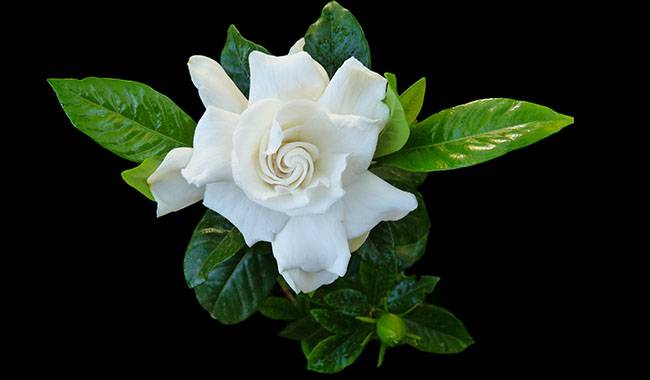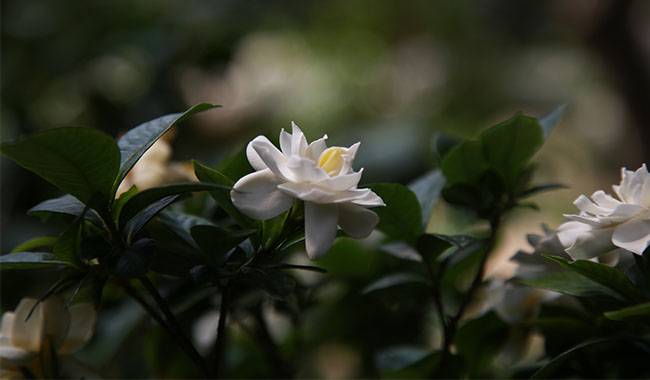
Gardenia flowers are often confused with camellias, so much so that they are mistakenly considered “absent.” Their status as an “elite flowering shrub not for everyone” is similar to these houseplants. Still, Gardenia plants are heat-loving, bloom in summer and fall, do not require a strict management regime, and have a fantastic fragrance. The exemplary flowers have a distinctive pure pearlescent and creamy hue that changes as they bloom, and the very pretty leathery foliage looks majestic. Their fragrance is inimitable, and their striking appearance is quite indicative of Gardenia’s expensive nature. You will learn how to Care Gardenia flowers in ThumbGarden’s article.
GARDENIA PLANT DESCRIPTION
Gardenia is not generally considered to be a plain house plant. It requires not only meticulous but also very thorough care. Make a conscious effort to purchase this legendary beauty.
Gardenia is cultivated as a cultivated houseplant. Evergreen shrubs are limited in height by form, and in indoor formats, Gardenia is usually kept to 15-20 inches (40-50 cm) or less, but they can be allowed to develop freely, forming tree-like silhouettes or even stumps up to 40 inches (1 m) tall.
Gardenia has a decomposing, broad, surprisingly dense canopy of densely packed branches that are slender, strong, and quick to sprout. The leaves grow in pairs or whorls of three. They are bushy and dense, leathery, small and glossy, elliptic-lanceolate, up to 4 inches (10 cm) long. Gardenia is surprised with its green color, which is deep and cool, very rich, and any variation will expose care problems.
Gardenia’s flowers are tubular, up to 3inch (7.5cm) in diameter, somewhat opaque, and glossy. They look waxy or porcelain and bloom in the axils of the leaves one at a time. In indoor varieties, the flowers are almost always furry, with oval-shaped petals overlapping into spirals and having a distinctive dense texture. The white buds and young flowers rapidly transform through all stages of buttercream hues to a deeper creamy yellow. Gardenia is characterized by an exemplary ivory hue.
Perhaps Gardenia’s most recognizable characteristic remains its fragrance. Even the plant’s extraordinary beauty cannot conceal its intense, delicate, intoxicating, complex, and bitter perfume-like fragrance, which is emitted by the luxurious flowers.
Gardenia’s flowering period traditionally lasts from June-July to October but depends on thorough care, temperature, and even exposure to fresh air. Gardenia often “lags” and reacts violently when brought outdoors.
GROWING CONDITIONS FOR GARDENIA INDOORS

It is easy to find a suitable location for this shrub. Gardenia prefers neither strong shade nor strong sunlight. However, they will develop perfectly in diffused soft light. Mild shade is ideal. Find a place for beauty not only on the windowsill but also indoors nearby. In winter, placing the shrubs on the sunniest windowsill in the house will increase the light to the maximum.
Gardenia is happy to move outside into the fresh air and decorate gardens and balconies in summer. Shady and well-protected locations in the garden and on the balcony are worth choosing.
For Gardenia, stable conditions are key throughout the germination phase. As soon as the buds start to form, you should avoid any rearrangement and try to ensure that the temperature is even (or at least limit the temperature rise). For the rest of the time, Gardenia does not like drafts and big changes.
During active growth, Gardenia prefers a stable temperature of around 68 °F (20°C). If they are moved outside, they will not notice the heat. However, it is best not to overheat the plant (especially the root system) in the room or to compensate for uncomfortable temperatures with careful care.
Gardenia has a distinct rest period that should be cool but relative. Hydrangeas do not require such low temperatures or strict regimes as camellias. This shrub is adequately prepared for winter in any cool, bright, or semi-shady location at temperatures of about 60 °F (16°C.) The lowest temperature Gardenia can tolerate is 50 °F (10°C). Increases to 68 °F (20 °C) and above will not affect flowering, but humidity must be increased proportionately.
HOW TO TAKE CARE OF GARDENIA PLANTS AT HOME

The care of Gardenia should protect the plant from sudden changes and stabilize conditions as much as possible. If the lighting and temperature are correct, a comfortable high humidity level is the key to the proper growth and health of this “beauty.”
Watering and humidity
Gardenia prefers constant moisture in the soil. It can be easily maintained by not over-watering the plant and only allowing the top of the substrate to dry slightly between waterings. Water should not remain in the tray for very long. Standing water and drought are equally dangerous to Gardenia, most often causing buds and sometimes leaves to fall off. During the rest period, watering is reduced, and the substrate is drier but still not completely dry.
Gardenia should only be watered with water warmer than room temperature 95-122 °F (35-50°C), choosing the mildest option. Rain is best for this plant, but you can intentionally acidify standing water to prevent soil response changes.
Gardenia likes moist air, and the higher the value, the more beautiful its green color. Initially, it is best to choose a sufficiently moist place for them or keep company with neighbors who like humidity. You can compensate for dry air in the house by simple means – use containers filled with pebbles or moss, with trays of moist expanded clay. They like to be sprayed, but only on the leaves. Spraying the flowers of the plants is one of the biggest mistakes when growing these plants.
With a minimum humidity of 40%, they are adequately prepared for winter in any cool, bright, or semi-shady location with winter temperatures above 60 °F (16°C.) The lowest temperature Gardenia will tolerate is 50 °F (10°C). Increasing to 68 °F (20°C) requires an increase to 70% or higher. Gardenia will also prefer the highest humidity during germination.
Foliage can be kept clean with polish or a simple wet wipe. Gardenia prefers warm showers.
Fertilization and Fertilizer Composition
Gardenia is not fertilized throughout the year but only at peak growth and wait 4 to 8 weeks after transplanting before restarting fertilization. From March to August, a full dose of fertilizer is applied at a frequency of approximately every 2-3 weeks. Gardenia also responds very well to foliar fertilization.
Fertilizers for Gardenia are easy to find: they are only satisfied with special azalea fertilizers or flowering plants in half doses. The plants need to get enough iron and magnesium. Before buying a fertilizer, it is good to check that the ingredients are complete and always have a special mono fertilizer on hand in case there are signs of wilting (light-colored spots on lush leaves).
Pruning and shaping Gardenia
Gardenia requires formative pruning. Branches are shortened, leaving at least 2-3 buds at the desired profile and size. To obtain a more natural form, you can let the shrub grow, limit the cuttings to the top and lightly prune the ends of long branches. Remove faded flowers regularly.
Transplanting, containers, and substrates
Repot Gardenia when the substrate is filled with roots, usually every two years. Repotting can be started in February or March when shoots begin to grow.
Gardenia doesn’t take long to find a substrate: they grow very well in special rhododendron soil. Their light and coarse texture make them ideal. You should add a coarse loosener and create a slightly acidic soil mixture if you prepare your soil.
Gardenia is carefully transplanted, keeping the root ball untouched. A high, thick drain should be placed at the bottom of the container. For Gardenia, do not change the level of immersion. Make sure the conditions after transplanting are as mild as possible. Excessive watering and drought are very dangerous.
Diseases, pests and cultivation problems
Gardenia reacts to almost all problems in the same way – dropping buds and flowers. And it is not only miswatering, misplacement, drafts, lack of light, but also heat that causes this reaction. Gardenia suffers more often from irrigation errors than pests, but these are not uncommon.
It is one of the favorite plants of aphids and lepidopterous insects and is not easily removed from the leaves. Cleaning and spraying with systemic insecticides is the best strategy.
F. Propagation of Gardenia
Simple cuttings propagate luxury Gardenia. Throughout its active growth phase, from spring to midsummer, the tops of non-flowering shoots that have not formed buds, about 4 inches (10 cm), containing two buds, can be cut off. After treatment with a growth promoter, the twigs are rooted in a standard substrate in a heated greenhouse.







